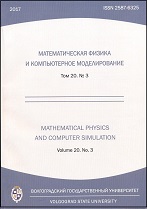|
Computer modelling
Numerical solution of initial boundary value problems for the heat equation by the method of integral equations
A. M. Afanas'ev, A. Yu. Glukhov, B. N. Siplivyi
Volgograd State University
Abstract:
Sometimes it becomes necessary to solve initial boundary value problems for the heat equation under various boundary conditions in the numerical study of the processes of moisture removal from moisture-containing materials by electromagnetic radiation. For some bodies of canonical geometry, one can obtain an analytic solution. For domains of arbitrary shape, a numerical algorithm based on the use of the Green's function of the Laplace operator is proposed. The study considers a solid body with a constant coefficient of thermal diffusivity $a$ and internal heat sources with a given density $f(M, t)$. Consequently, the solution of the initial boundary value problem for a body with a surface $S$ and volume $V$ determines the temperature field inside the body. If the Green's function $G(M, N)$ of the Laplace operator is known for one of the listed boundary conditions, then the desired solution can be represented in the form (for boundary conditions of the first kind $\alpha = 1, \beta = 0$). As a result, the relation is an integral-differential equation with respect to $T(M, t)$. The integral operator generating this equation is self-adjoint in the class of quadraticallyintegrable functions. Therefore, the Hilbert–Schmidts theorem is applicable for the solution. Expanding the functions $T(M, t)$, $f(M, t)$ into series in eigenfunctions of the integral operator obtains the Cauchy problem for the coefficient $c_k(t)$ of the expansion $T(M, t)$. Carrying out the necessary transformations, the solution of the starting initial boundary value problem is expressed in terms of eigenfunctions and the number of the kernel $G(M, N)$ which can be calculated by the Kellogg method. The authors propose the certain form of the kernel $G(M, N)$ which is necessary for the realization of this method. Thus, putting N consecutively points into the boundary points and equating the results to zero it obtaines a system of linear algebraic equations for ci. As a result, the proposed method for constructing $G(M, N)$ can be treated as a generalization of electrostatic images method to regions of arbitrary shape. In addition, the study obtains expressions for boundary conditions of the second and third kind. Thus, the proposed method makes it possible to take into account boundary conditions of various types in a natural way.
Keywords:
heat equation, Green's function of the Laplace operator, integral-differential equation, proper functions and numbers, initial boundary value problems.
Citation:
A. M. Afanas'ev, A. Yu. Glukhov, B. N. Siplivyi, “Numerical solution of initial boundary value problems for the heat equation by the method of integral equations”, Vestnik Volgogradskogo gosudarstvennogo universiteta. Seriya 1. Mathematica. Physica, 2017, no. 2(39), 65–74
Linking options:
https://www.mathnet.ru/eng/vvgum173 https://www.mathnet.ru/eng/vvgum/y2017/i2/p65
|

| Statistics & downloads: |
| Abstract page: | 230 | | Full-text PDF : | 74 | | References: | 50 |
|




 Contact us:
Contact us: Terms of Use
Terms of Use
 Registration to the website
Registration to the website Logotypes
Logotypes








 Citation in format
Citation in format 